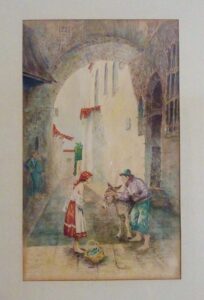 BH owns an Italian watercolor genre painting featuring a classic genre style figuration. A buxom peasant girl wearing a very loose blouse listens to a man who leads a burro. She dropped her basket on the stones of a village street. The corridor of stone buildings shows an onlooker, a young man in blue. The work is signed illegibly. It’s an event, but what’s happening? Does the man with the burro proposition the girl?
BH owns an Italian watercolor genre painting featuring a classic genre style figuration. A buxom peasant girl wearing a very loose blouse listens to a man who leads a burro. She dropped her basket on the stones of a village street. The corridor of stone buildings shows an onlooker, a young man in blue. The work is signed illegibly. It’s an event, but what’s happening? Does the man with the burro proposition the girl?
What we call a genre painting is accurately a STYLE of painting with distinctive realistic features. Known for visual narratives of real people in real settings carrying out real lives, whether high born, or low born.
Two elements apply. For the high-born figures portrayed, this style requires historical architectural setting and clothing. For the low-born folks this style requires images of a simpler, more earthy ways of life, hearkening back to a more rural lifestyle. No wonder. This style became popular throughout Europe after the world experienced the Industrial Revolution. Both the aristocratic palace nobles and the lowly peasant on the idyllic farms, became a thing of the past as modernism grew. The high and the low both show people dressed for theatrical performance, undertaking common activities for their ‘class.’ For example the noble aristocrat engaged in cards with other noble cardsharps. They showed lowly eating, smoking, drinking, and as we see in BH’s image, flirting.
Sentimentality and Sexuality
Usually these genre images contain a suggestion of both sentimentality and sexuality. Not surprising for the late 19th century Victorian’s suppression of sexuality.
Although the style reached its zenith in the late 19th century, it began in Italy in the 17th century with greats like Caravaggio. Artists in Italy took two avenues to pursue after such a genius. Religious art became weighty and seriously painted for profound impact in dramatic deep colors. Or art became scenes of everyday life “narrated” by realistic figures in understandable settings, rendered in freer brushstrokes, and often sentimentalized, using a ‘sweeter,’ softer toned palette.
The aristocratic genre paintings of the late 19th century show lavish historical interiors, silk clothing, powered wigs, leisurely pursuits, lots of decolletage, painted in exuberant “candy box” colors. On the other hand, images of humble peasants showed lifelike realism. The subjects usually dressed in distinctive regional rural garb. Fast becoming obsolete, they depicted certain types of labor, such as net-fishers, portly monks making wine, busty milkmaids, craggy old men smoking huge pipes, children feeding farm animals. These works feature farmhouses, village streets, crofter’s cottages, and great detail as to settings and clothing. They often portrayed something of a humorous nature, like the scantly clothed young female chased by a flock of geese. Children, either children of great wealth, or beggar children, were romanticized and often subjects of genre paintings. Handsome young lovers as they courted in the Italian village or on the boats of Lake Como were favored. Simple village dramas played out in these paintings, too.
Genre Paintings Not in Favor Today
This is due to their realism and sentimentality, and because they idolize non-modernity. In that extremely popular era, collectors were the post-Industrial Revolution urbanites, the wealthy elites, and the noveau riche. In other words, those that needed a work of art to tell them a story. Not the “old money” who already owned paintings, but the “new money” with little art background. The collectors of genre work admired the narrative behind the image.
Although the style began in Italy, by the 19th century the popularity of realistic narrative paintings of “real” life spread to France, Holland, America, England, and Germany. Each aforementioned country had their own special subjects. For example, the genre paintings of England and Germany often included a dog or a horse. French genre paintings often show us country priests in their robes, or beautifully dressed 18th century people in palace interiors. In Holland we see bonneted middle-class women in their perfectly neat kitchens. In the US genre painters loved working-class children, the Huck Finn archetype, barefooted tough boys who often smoked cigarettes. The American collector also bought plenty of morality-style images, for example, the sad, disappointed former wayward “lady of the evening.”
BH’s genre painting is worth $250.